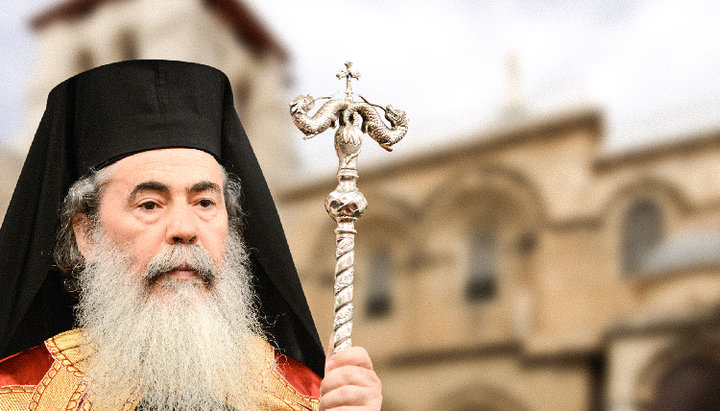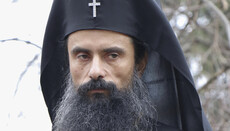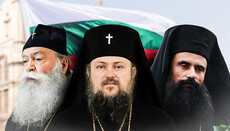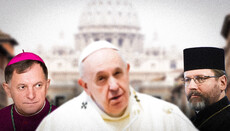Is the Jerusalem Church the Mother of all Churches?

How to relate to the assertion of Patriarch Theophilos III of Jerusalem that his Church is the guarantor of the unity of the entire Orthodox world.
On May 16, 2019, Patriarch Theophilos III of the Holy City of Jerusalem and All Palestine received a delegation of the Imperial Orthodox Palestine Society (IOPS). In his welcome address, the Patriarch of Jerusalem said the words that deserve attention in light of the events taking place in the Orthodox world today: "The Jerusalem Church, which is the Mother of all Churches, is the guarantor of the unity of the Orthodox Church."
What could be hidden behind this seemingly innocuous wording?
The IOPS held an international seminar in Jerusalem for the heads of its regional and foreign branches and representative offices. It was dedicated to the 200th anniversary of the diplomatic support of the Russian presence in the Middle East.
Patriarch Theophilos III said many pleasant words to the delegation of the IOPS and published a welcome speech on the official website of the Jerusalem Patriarchate. “We especially recognize the role that the Russian Orthodox Church has played for centuries, especially during the Ottoman period, in supporting the Jerusalem Church politically, diplomatically and, of course, financially,” the Patriarch said.
All this is true. It is not known what the fate of the Orthodox Churches in the Middle East would have been – and these are the oldest Churches of Constantinople, Alexandria, Antioch, and Jerusalem – but for the help of Rus. Political, diplomatic and financial. In many respects precisely due to this help, the oldest Churches still exist.
But among these pleasant words, there was a phrase that should alert: "The Jerusalem Church, which is the Mother of all Churches, is the guarantor of the unity of the Orthodox Church."
As it is known, Constantinople declared itself the Mother of all Churches. Moreover, the Phanar claims that the Orthodox Church as such cannot exist without the Patriarchate of Constantinople. The Phanar also said that it is this patriarchate that is the guarantor of the unity of the Orthodox Church, that all Local Orthodox Churches can be considered as such only insofar as they are in communion with the Patriarchate of Constantinople.
And now the Patriarchate of Jerusalem declares the same thing. How legitimate are such statements? In the comments under these words of Patriarch Theophilos III, many express the view that, historically, yes, they are completely legitimate. However, things aren’t that simple.
"The Jerusalem Church, which is the Mother of all Churches, is the guarantor of the unity of the Orthodox Church."
Patriarch Theophilos III of Jerusalem
Indeed, the Church of Christ, which received its historical existence in the Zion Upper Room on the day of the descent of the Holy Spirit on the apostles, was equal to the Jerusalem community of not even Christians (this name was adopted for the first time in the community of Antioch) but simply of disciples. The apostles left Jerusalem to preach in all corners of the world. The Jerusalem community, by its moral height, was the ideal of the Christian community, which no other community has ever reached.
For the resolution of perplexing questions, the Christians of the first decades turned specifically to the Jerusalem community. In this sense, it is entirely legitimate to assert that the Jerusalem Church or rather the first Jerusalem apostolic community is the Mother of all the Churches. However, the current Jerusalem Local Church is related to the first apostolic Jerusalem community indirectly rather than directly.
The book of the Acts of the Apostles gives us a glimpse of the first Christian community. Ethnically, it consisted of Jews, who were conditionally divided into two groups: Jews and Hellenists, and the latter means not the Greeks, but the Jews of dispersion, who lived in other countries and spoke Greek. As an exception, the Holy Scripture mentions the pagan Nicholas of Antioch.
Despite the decision of the Apostolic Council of 49 AD on the non-obligation for pagans who converted into Christianity to observe the commandments of the Law of Moses, the members of the Jerusalem community themselves respected this Law rather scrupulously. The evidence of the II century Christian chronicler Hegesippus suggests that the descendants of the relatives of the Lord Jesus Christ by the flesh, the first of whom was James, the brother of the Lord, were successively the bishops of Jerusalem.
During the First Jewish uprising against the Romans (66–70 AD), the Jerusalem Christians fled to the town of Pella and thus avoided the horrors of the siege of Jerusalem and its subsequent devastation. After 70 AD, some Christians returned to Jerusalem, and the Christian community in this city resumed. However, its influence on other communities, especially in Rome, Alexandria, and Antioch, virtually ceased.
But during the Second Jewish uprising under the leadership of Bar-Kochba (132-135 AD), this Jerusalem Christian community was completely destroyed and ceased to exist. Moreover, it was struck from two sides. The rebellious Jews exterminated members of the community as Christians, and the Romans – as Jews. The suppression of the Bar Kochba revolt by the Romans was very cruel. Jerusalem was destroyed to the ground, and the surviving population was sold into slavery or fled. The Roman emperor Hadrian forbade Jews under penalty of death not only to live in Jerusalem but also to approach it.
An entirely new pagan city, Aelia Capitolina, was built on the site of destroyed Jerusalem. It was settled by veterans of the Roman legions and ethnic Greeks. There was nothing in Aelia Capitolina that was connected either with the former Christian community or with the history of Jerusalem, Palestine, the Jewish culture and traditions.
The church historian Eusebius of Caesarea indicates that the Christian community soon reappeared in Aelia Capitolina, but it was already Greek by ethnic composition and in no way connected with the first Jerusalem community. The role of this community and, accordingly, of the episcopal see was insignificant for several centuries. A much bigger role was played by another see in Palestine – of Caesarea.
The rise of the Jerusalem See occurred already in the IV century under the emperor St. Constantine the Great. It was the result of the acquisition of the main Christian shrines by Queen Helena – the Holy Sepulcher, the Life-Giving Cross and others – and the beginning of a large-scale pilgrimage of Christians to these shrines.
In 451 AD, by the decision of the IV Ecumenical Council, the Jerusalem See was granted the status of patriarchate, with the subordination of the Christian communities in Palestine. However, taking into account the breakup of the first Christian community in Jerusalem in 132-135 AD, as well as the insignificant political position of Jerusalem, the Ecumenical Council determined the Jerusalem Church not the first place in the diptych, as it would seem, but only the fifth, after those of Roman, Constantinople, Alexandria and Antioch.
As a result of the Arab invasion in the VII century, Christianity in Palestine in general and the Jerusalem Patriarchate in particular declined. It intensified even more after the conquest of Palestine by the Crusaders in 1099 when the Latins seized Orthodox churches and transferred them to the Vatican. After the conquest of Palestine by the Turks in 1599, the position of the Jerusalem Patriarchate improved significantly.
As for the ethnic composition of the Jerusalem community and its primates, as we have said, it has been Greek since the first half of the 2nd century. In the era of Arab rule, the community became predominantly Arab. And after the last Jerusalem Bishop-Arab Dorotheus II (XVI century) and to this day, the Jerusalem Patriarchate has the following picture: the episcopate and a significant part of the clergy are Greeks, and the flock is mostly Arabs.
This state of affairs has caused and still causes many conflicts between the congregation and the episcopate. Today, the Patriarch of Jerusalem belongs to the notional cluster of Greek Local Churches, which in their policies traditionally focus on Constantinople.
Based on this small historical overview, let everyone decide on their own discretion the question of whether it would be historically correct to call today’s Patriarchate of Jerusalem the Mother of all Churches. And it is not so important whether or not there are historical grounds to recognize any Patriarchate as the “Mother of All Churches” as the question whether such recognition entails any privileges for such a Patriarchate in the modern life of Local Churches.
Much more important and ambiguous is the claim of Patriarch Theophilos III that the Jerusalem Church "is the guarantor of Orthodox unity".
The doctrine of the unity of the Church is one of the fundamental dogmatic truths included in the Nicene-Constantinopolitan Creed: "I believe in One, Holy, Catholic, and Apostolic Church." Therefore, if we start saying that someone, some Local Church – Jerusalem, Constantinople or some other – is the guarantor of Orthodox unity, the logical question is: who then will be the guarantor of the doctrine of the Most Holy Trinity or the incarnation of Jesus Christ?
It is not so important whether or not there are historical grounds to recognize any Patriarchate as the “Mother of All Churches” as the question whether such recognition entails any privileges for such a Patriarchate in the modern life of Local Churches.
The next logical step in such reasoning will be the question: who is the guarantor of the purity of dogma in general? Who has the authority in the Church to determine where the Truth is and where is its distortion? This question arose many centuries ago. And it was decided in different ways in Catholicism and Orthodoxy.
For the Latins, the Roman Pontiff is the guarantor of all the moral and spiritual teaching, without exception. He is the visible and tangible criterion for determining the purity of faith. The dogma of papal infallibility is formulated by the Latins as follows: “We teach and define that it is a dogma Divinely revealed that the Roman pontiff when he speaks ex cathedra, that is when in discharge of the office of pastor and doctor of all Christians, by virtue of his supreme Apostolic authority, he defines a doctrine regarding faith or morals to be held by the universal Church, by the Divine assistance promised to him in Blessed Peter, is possessed of that infallibility with which the Divine Redeemer willed that his Church should be endowed in defining doctrine regarding faith or morals and that therefore such definitions of the Roman pontiff are of themselves and not from the consent of the Church irreformable. So then, should anyone, which God forbid, have the temerity to reject this definition of ours: let him be anathema.”
In Orthodox Christianity, there is no similar clearly defined and documented dogma about who is infallible and, therefore, can be the guarantor and guardian of dogma and morality. However, in Orthodox tradition, there is an understanding that only the fullness of the Church of Christ can be such a guardian and guarantor. It is said about the Church that it is "the pillar and ground of the Truth" (1Tim. 3, 15). It is the Church that the Lord promised that “the gates of hell shall not prevail against it” (Matthew 16, 18).
The Church is not some visible (more precisely, not only visible) and even more so the sole institution. There is no well-defined procedure of actions, following which, the Church can show its infallibility in defining the dogmas of faith and protecting them from false doctrines. There is neither a clearly defined procedure for convening the Ecumenical Councils, nor who is entitled to convene them, nor how many bishops from each Local Church should participate in them, nor how these delegates should be appointed to the Council. There is no procedure for the implementation of the decisions of the Council. There is no executive body responsible for this, etc.
But despite all these difficulties, the Church has been always aware of itself as the only guarantor of the preservation of Truth. Here is how this awareness is expressed in the Encyclical of the Eastern Patriarchs (1848) (it was addressed “to All the Genuine Orthodox Sons of the One, Holy, Catholic and Apostolic Church”): “Neither Patriarchs nor Councils could then have introduced novelties amongst us because the guardian of our piety (iperaspistis tis thriskias) is the very body of the Church, even the people themselves, who desire their religious worship to be ever unchanged and of the same kind as that of their fathers."
Even Councils do not always guarantee the truth of the decisions taken at them. In the history of the Church, there have been several cases when Councils possessing all the features of the Ecumenical ones were, in fact, predatory and were recognized as such after more or less long periods of time.
Let us imagine the situation in which the Christians found themselves when such a predatory Council was not yet recognized as predatory. After all, the supporters of such a pseudo-council argued to everyone that they were right and that the Ecumenical Council allegedly made particular decisions binding for everyone. Let's imagine how hard it was for the Orthodox to prove and defend their Orthodox faith at that time. All these problems and difficulties seemed to push Christians to a rather simple decision – to establish that a person or a collegial body in the Church with clearly defined powers and decision-making procedure would be the visible guarantor of the purity of moral and spiritual teaching.
In Orthodox Christianity, there is an understanding that only the fullness of the Church of Christ can be the guardian and guarantor of doctrine and morality.
The Latins succumbed to such a temptation and easily transferred this function to the Pope. It is very simple and convenient – to have a visible guarantor and place all responsibility for making decisions on him.
But the Orthodox have always rejected such a temptation and firmly defended the assertion that the Church in its fullness is ruled by the Holy Spirit, who Himself creates forms and procedures for himself. More than once in the history of the Church, the decisions of the Ecumenical Councils were rejected, so that later they would triumph after decades or even centuries of struggle for the purity of Orthodox faith. More than once in the history of the Church there have been instances when the Truth was defended by only one bishop, for example, Mark of Ephesus at the Ferrara-Florence Council. But in the end, Truth won. The Holy Spirit led the Church through seemingly insurmountable difficulties and barriers to the Truth, led the ways only He knew.
To recognize the existence of a visible guarantor of dogmatic truths means to reject this guidance of the Holy Spirit. And the second question is who should be appointed such a "guarantor": the Roman Pontiff, the Patriarchate of Constantinople, Jerusalem or Russia?
I really want to think, the words of Patriarch Theophilos III of Jerusalem that the Jerusalem Patriarchate “is the guarantor of the unity of the Orthodox Church” are just words that will not be translated into action. Otherwise, the claims of the Jerusalem Patriarchate to what belongs to the full Church of Christ must be rejected, just as today's claims of the Patriarchate of Constantinople to primacy are rejected.





